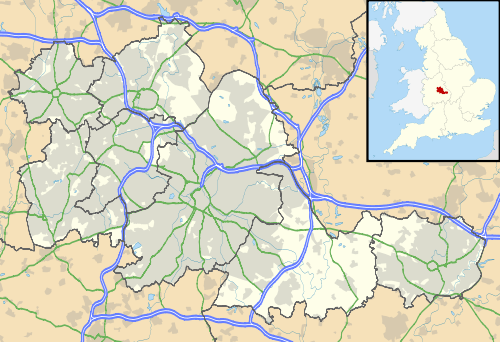Kingshurst
| Kingshurst | |
 Kingshurst |
|
| Population | 7,868 (2011)[1] |
|---|---|
| Civil parish | Kingshurst |
| Metropolitan borough | Solihull |
| Metropolitan county | West Midlands |
| Region | West Midlands |
| Country | England |
| Sovereign state | United Kingdom |
| Post town | BIRMINGHAM |
| Postcode district | B37 |
| Dialling code | 0121 |
| Police | West Midlands |
| Fire | West Midlands |
| Ambulance | West Midlands |
| EU Parliament | West Midlands |
| UK Parliament | Meriden |
|
|
Coordinates: 52°29′17″N 1°44′53″W / 52.488°N 1.7480°W
Kingshurst is a post-war housing estate and civil parish in the Metropolitan Borough of Solihull, in the West Midlands. It lies about 9 miles (14 km) east of Birmingham city centre. The Smith's Wood area of Solihull borders it to the north and east, Fordbridge to the south and the Shard End area of Birmingham to the west.
History
The name Kingshurst comes from having previously been a Royal Manor, and "hurst" meaning wood. The earliest record of Kingshurst is in documents from the late 13th and early 14th centuries, when it is referred to as part of the Manor of Coleshill. Tenant farming was administered from here and Simon de Montford of Coleshill was an English nobleman who built a moated manor house near Kingshurst. The Hall had its own park and farmlands.
The Mountfords 1332-1618
Kingshurst took on an independent existence from Coleshill with the arrival of the Mountfords. It is unclear how Kingshurst came into their possession although it is probable that they bought the area around 1332 from the Clintons, who were then Lords of the Manor at Coleshill. What is certain is that they were in possession by about 1352.
The Mountfords trace their ancestry back to Gilbert de Gant, who fought with William the Conqueror in 1066. He married Alice, daughter of Hugh de Montfort, another of the knights who accompanied Duke William on his English expedition. As a result of this connection Gilbert's son, named Hugh de Gant, changed his name to Hugh de Monfort and from then on the name continued becoming Mountford by the 15th century.
The end of Kingshurst Hall
The last proprietor of Kingshurst Hall, Walter Townsend, lacked the means to prevent the house from falling into a state of disrepair. All plans to salvage it came to nothing, due to a lack of funds. In 1960, Walter was moved to a house in Castle Bromwich and in 1962 the hall was demolished.
The remains of the moat of Kingshurst Hall are still visible today.
Yorkswood
During World War I, much of the woodland in Kingshurst was cut down to help with the war effort. The Birmingham and District Association of Boy Scouts were able to buy a patch of land at a bargain price and set up a permanent camp there. This land was half way between Kingshurst and Shard End. It was called Yorkswood and opened in 1923. There were five camp fields, covering an area of 25 acres (100,000 m2). The total site was over 200 acres (0.81 km2). The site benefited from permanent washhouses and latrines, a swimming-pool, a training centre and headquarters, guesthouse, warden’s hut and other huts. A small brook from a fresh water spring ran past the camp and Cock Sparrow Farm was about 100 yards (91 m) away to provide fresh milk.
The entrance to the camp was flanked by a series of griffin statues. These had come from the roof of Lewis's Department Store on Corporation Street in Birmingham when it was being renovated. After the camp closed in 1972, they were placed on the housing estate (Kendrick Avenue and nearby roads) built upon the site of the camp.
Kingshurst today
Kingshurst is now a mainly residential area. Built as an overspill housing estate built in the early 1950s for the City of Birmingham, it became part of the Metropolitan Borough of Solihull in 1974.
There are three primary schools, Kingshurst, St. Anthonys and Yorkswood, a library and a small shopping area. The Anglican church is dedicated to St Barnabas and is situated off Church Close, the Catholic church is dedicated to St Anthony, the Methodist Church situated in Gilson Way and there is an evangelical church, Kingshurst Evangelical Church (KEC Church) situated on Cooks Lane corner with Forth Drive, which is much involved within Kingshurst Community. The nearest secondary schools are Smith's Wood Sports College, across the Chester Road in Smith's Wood, the CTC Kingshurst Academy, and John Henry Newman Catholic College which are off Cooks Lane. There is a small local park off Gilson Way/Marston Drive next to a main shopping area. The children's play area is the main facility with the freedom to play outdoor games and activities.
According to the 2001 census, Kingshurst has a population of 8,126.[2]
Notable residents
Gary Shaw, the former Aston Villa footballer, was born at a house on Meriden Drive in January 1961 and lived there until the 1980s, by which time he was established as a key player at Villa. Female rapper Lady Leshurr was born and raised in Kingshurst.
Parish council
Kingshurst has a parish council, to which it elects 12 members every four years.
References
- ↑ "Civil Parish population 2011". Retrieved 16 December 2015.
- ↑ Office for National Statistics : Census 2001 : Parish Headcounts : Solihull Retrieved 2009-11-22
External links
| Wikimedia Commons has media related to Kingshurst. |
- Map of Kingshurst
- City Technology College
- http://www.northsolihull.co.uk/ North Solihull Regeneration Website